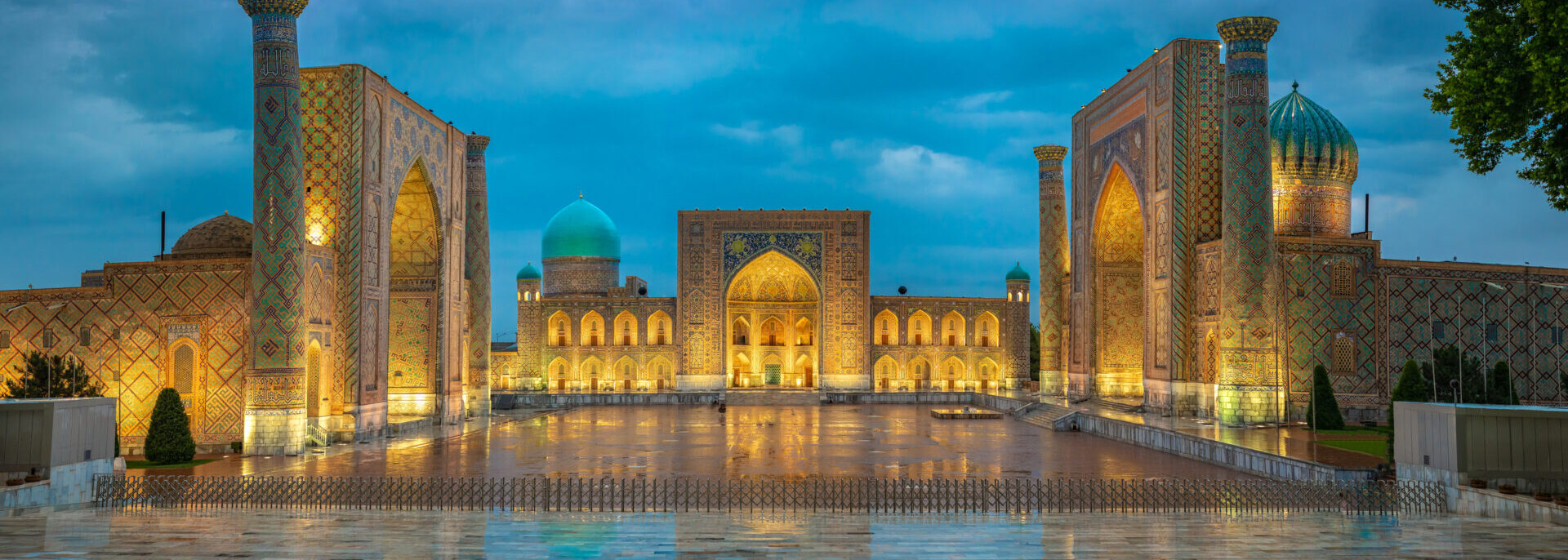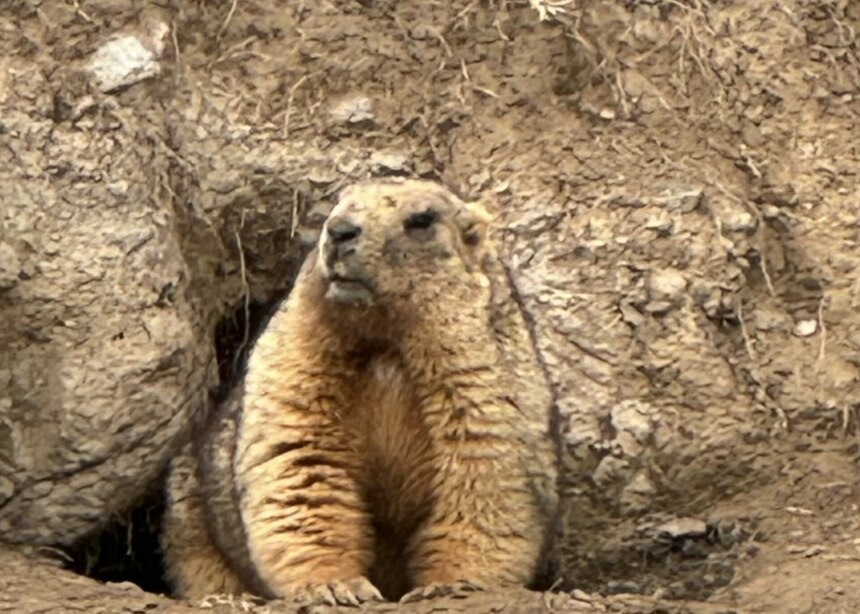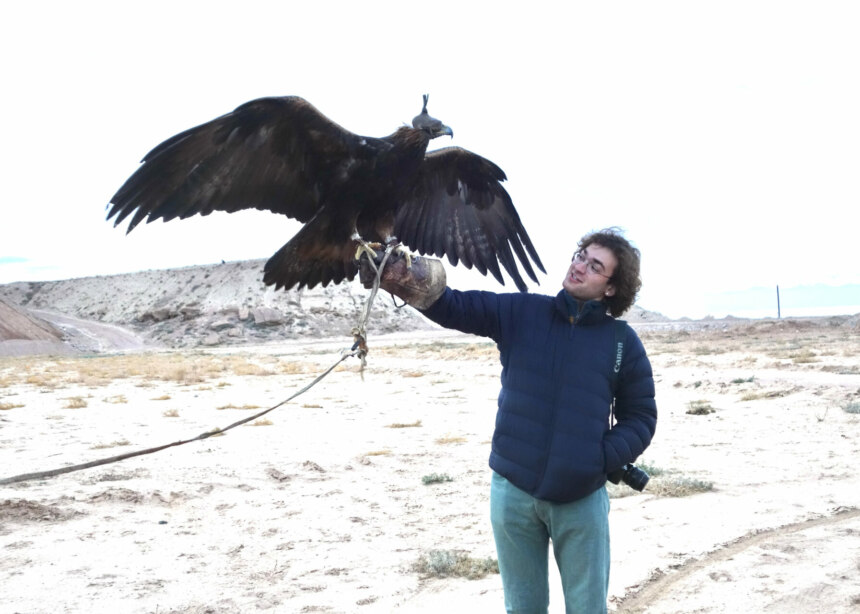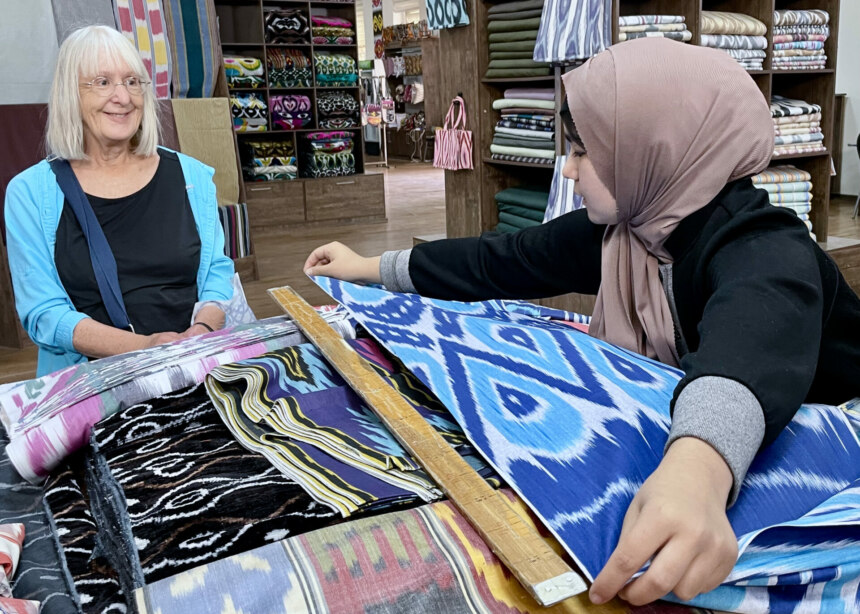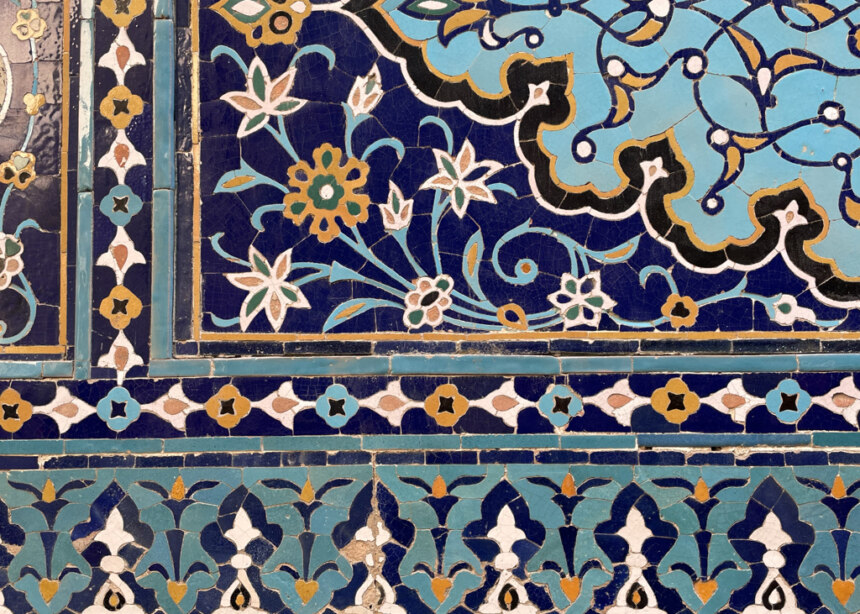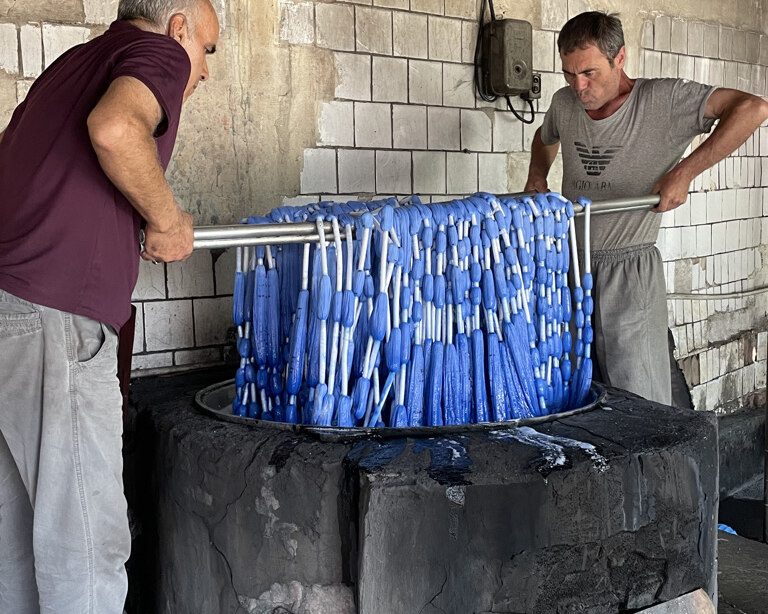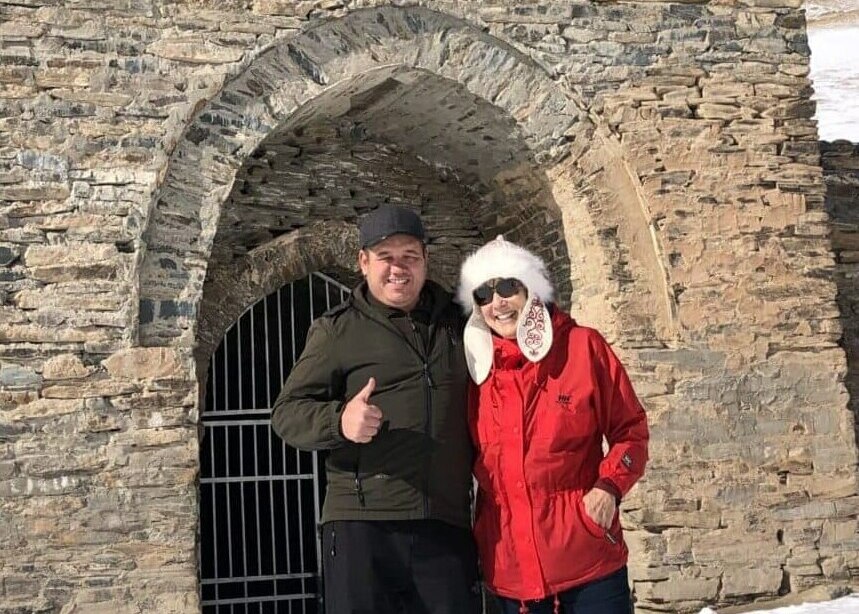Our 24-night textiles, art and architecture tour of Uzbekistan and Kyrgyzstan checks another fabulous adventure off your bucket list!
On this spectacular tour, we’ll be following part of the Silk Road, the ancient trade route that linked the Mediterranean to China! These ancient artistic exchanges and shared aesthetic traditions practically assured that nowadays the region would be home to large numbers of talented artisans. Uzbek textile artists create exquisite hand-embroidered suzanis and brilliant hand-dyed, handwoven ikat fabrics. Kyrgyz women have expanded traditional nomadic-style felt-making (yurts and rugs) to produce innovative craft items such as cozy slippers and small needle-felted animals.
In both countries, we will meet the welcoming artisans and see their weaving, dyeing and felting techniques first-hand.
Bishkek, the Kyrgyz capital, has modern hotels, tree-lined streets and verdant parks. The restaurants are superb and serve a great variety of fresh and healthy foods.
TRIP HIGHLIGHTS
- Visit exquisite blue-tiled madrasas, mosaic-covered mosques, and fascinating museums
- Design and make your own silk and felt scarf in our workshop in Bishkek
- Meet silk ikat dyers and weavers, woodblock printers, and embroidery and ceramic masters
- Meet Kyrgyz feltmakers and learn their methods of making shyrdak rugs
- Walk the historical neighborhoods of ancient Samarkand and Bukhara to see UNESCO Heritage sites
- Shop in the bustling markets and handicraft bazaars of Bishkek and Bukhara.
What’s Included in The Trip?
An Overview of Our Journey
Arrival in Tashkent!
The trip begins in the spotless, modern city of Tashkent, the Uzbek capital. The official arrival date is April 1; you’ll be met at the airport early on April 1 whenever your flight arrives. Your hotel is reserved for the night of March 31 so you can sleep when you arrive. We’ll suggest some flights to arrive in Tashkent. Then that afternoon, we’ll meet for lunch and an easy half-day of sightseeing around the city. Big sycamores line the wide avenues of this beautiful city, and Russian-era mosaic-decorated apartment blocks alternate with sleek new glass and steel edifices.
In Tashkent’s old city, we’ll admire historical buildings with iconic turquoise-tiled domes, such as the 16th c. Barak-Khan Madrasa complex. We’ll also visit the home/studio of a famous embroiderer’s workshop and school, and see her beautiful jackets and coats. One of the days in the capital, we’ll go to the huge Chorsu Bazaar to meet the bread bakers and ride the subway to see the artistically decorated underground stations.
We’ll be sure to see the Museum of Applied Arts which showcases some of the best historical examples of the arts of Uzbekistan, in the mansion of the Imperial Russian diplomat Alexander Polovtsev. He commissioned the intricately decorated mansion expressly to display his extensive collections of unique handicrafts and textiles. After the Soviet revolution, the government nationalized his cherished home and opened it to the public as a museum. Polovtsev’s rare examples of vintage folk art such as ikat fabric, suzanis, ceramics, handmade rugs, and wood carvings are on display in the wondrous house with its colorfully decorated ceilings.
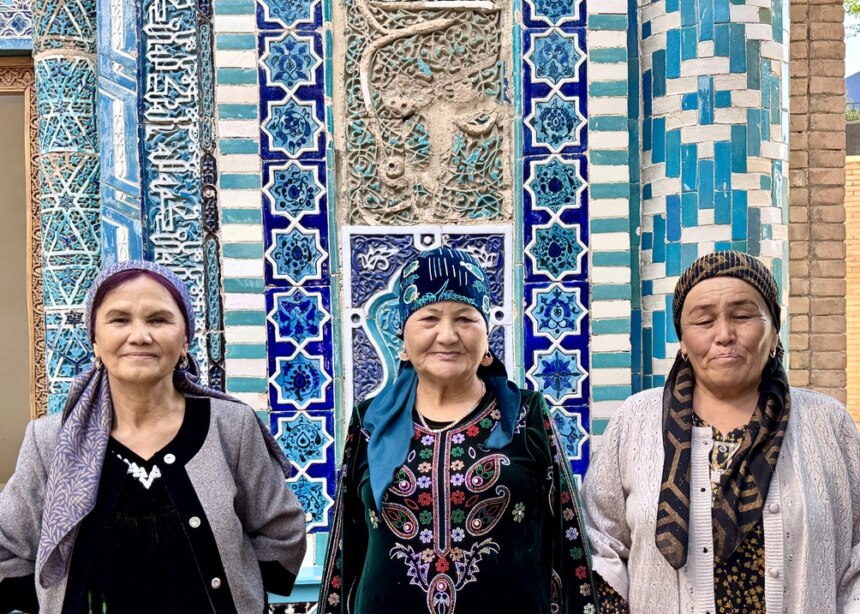
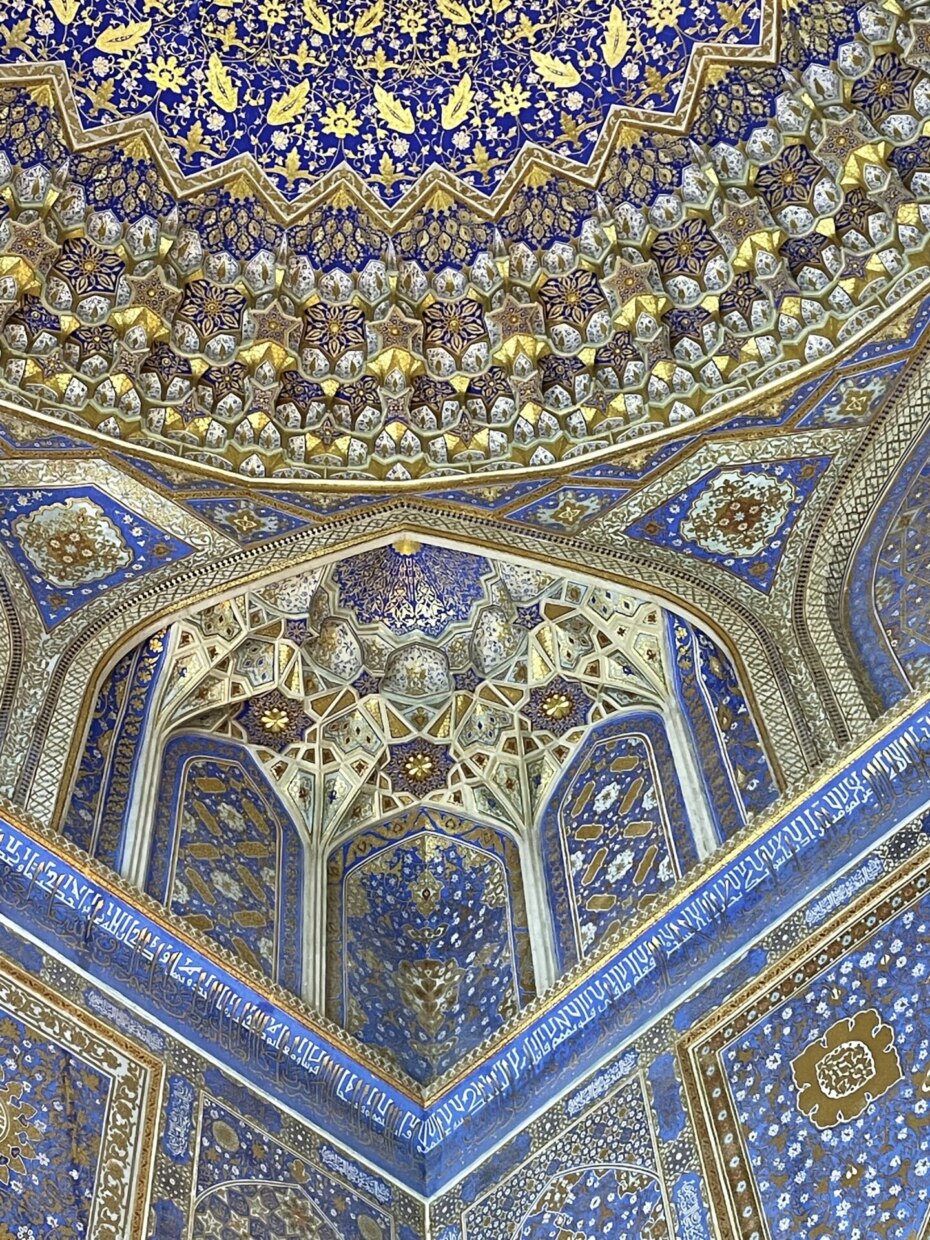
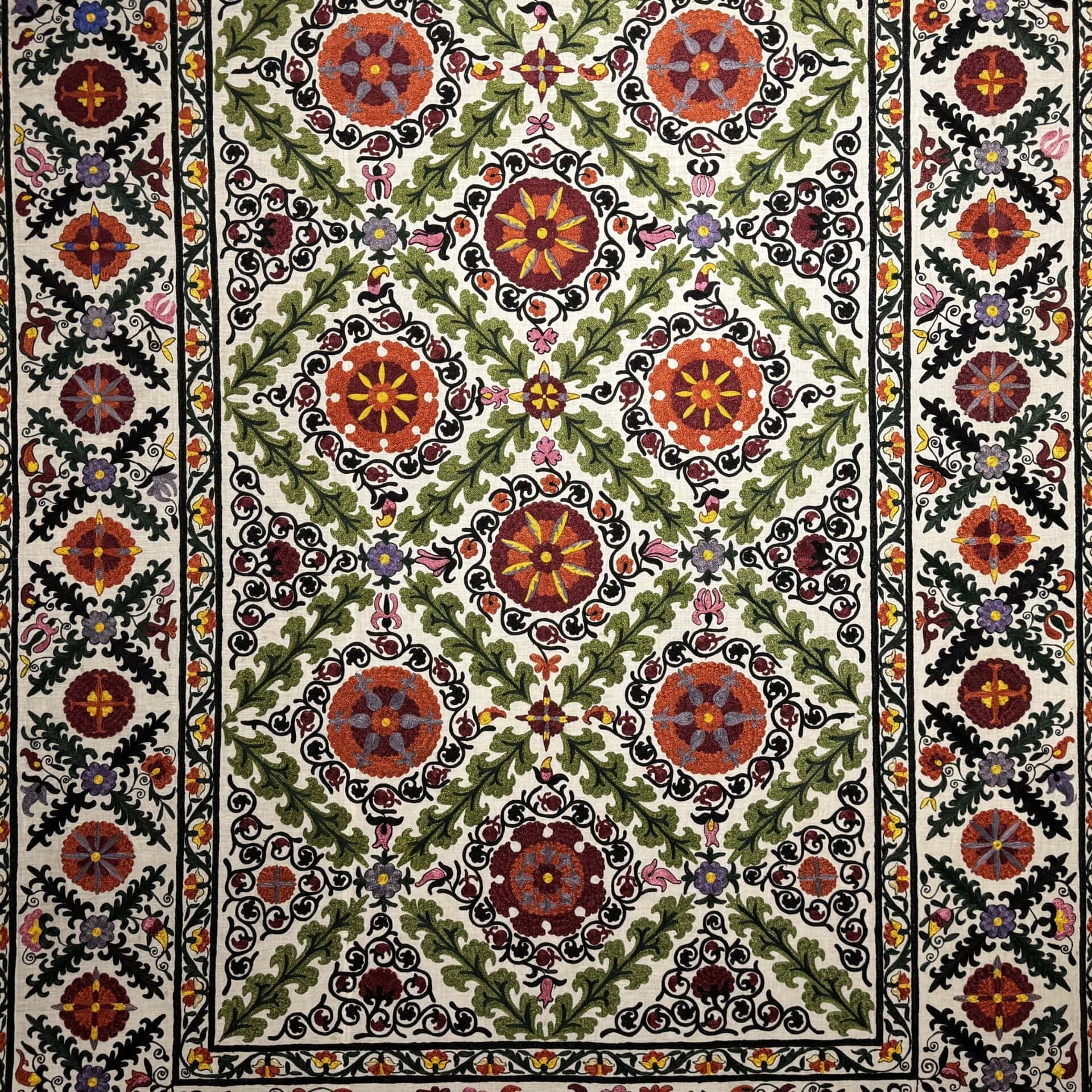
Samarkand
From Tashkent we board the comfortable, air-conditioned fast train to Samarkand. Seasoned travelers consider Samarkand to be one of the most beautiful cities in the world, not only for the stunning turquoise-domed historical monuments but also for the tree-shaded avenues and lovely green parks. Samarkand was an important trade stop along the Silk Road and was at the forefront of early Islamic architecture.
We’ll visit the mausoleums of Shah-i-Zinda, where Tamerlane built elaborate tiled mosaic tombs for his favorite wives and sisters. We’ll also visit a handmade carpet workshop and the towering tomb of Emir Timur (Tamerlane), founder of the Timurid Empire. Prominent landmarks include the iconic Registan, a plaza bordered by three ornate, tile-covered madrasas dating to the 15th and 17th centuries.
We’ll visit Registan Square in the daytime as well as at night when it’s lit with floodlights and looks magical. Modern Samarkand combines the spirit of modernity with old historical grace. The western part of the city is more modern, with architecture reflecting 19th and 20th c. European design and style, influenced by the Russian “Brutalist style” cement architectural aesthetic—as well as 21st c. towering modern glass and steel buildings.
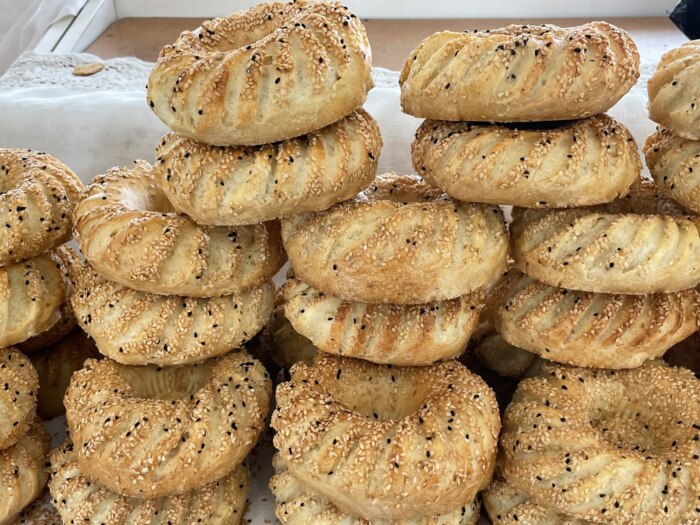
Next Stop Bukhara!
In the historic area of Bukhara, turquoise-domed mosques and madrasas comprise an important UNESCO World Heritage site. Detailed tile mosaics with masterful calligraphic panels decorate these stunning ancient buildings inside and out. The historic center of Bukhara, situated on the Silk Road, is more than two thousand years old. It is one of the best examples of well-preserved Islamic cities of Central Asia of the 10th to 17th centuries, with an urban fabric that has remained largely intact. It was a major medieval center for Islamic theology and culture. Bukhara still contains hundreds of well-preserved mosques, madrassas, bazaars and caravansarais, dating largely from the 9th to the 17th centuries. Several ancient, domed buildings here still function as bazaars, offering carpets, typical suzanis (embroidered panels) and jewelry.
Important monuments that survive from early times include the famous Ismail Samani mausoleum, impressive in its monochromatic elegance of unglazed bricks set in decorative patterns. It’s considered the best surviving example of 10th century Muslim architecture in the whole world.
While in Bukhara, we’ll see the Emir’s summer palace, Sitorai Mohi Hosa. It’s an extravagantly decorated Russian/Central Asian complex built in 1911. The palace also houses the excellent Bukhara Museum of Decorative Arts where the superb suzani collection will enthrall the embroidery lovers among us. The main building with its tall ceramic fireplaces houses treasures such as royal furniture of the 19th-20th centuries, palace artifacts from Russia, crystal chandeliers, and jewelry by well-known Bukharan masters.
On to Khiva
Onward from Bukhara to Khiva! This is a long drive, but the desert landscape is compelling: vast steppes, shepherds and their flocks of goats and sheep, remote villages, and unusual vegetation. We’ll skirt the Kyzylkum or Red Sand Desert, and cross the Amu Darya River, known as the Oxus in ancient times.
Ichan Kala, the walled inner city of Khiva was an important stop on the Silk Road. It’s also the largest surviving walled city in the central part of Asia.
Tiled and mosaic-encrusted treasures of Khiva’s old town include stunning palaces, mosques and minarets. We’ll walk through the striking and ancient Juma Mosque, with its 200-plus hand-carved wooden pillars. There is a good carpet shop in Khiva that we will visit also. Hand-knotted examples here exhibit subtle color combinations and unusual and intricate patterns that were inspired by the designs of the tiles and doors of the city.
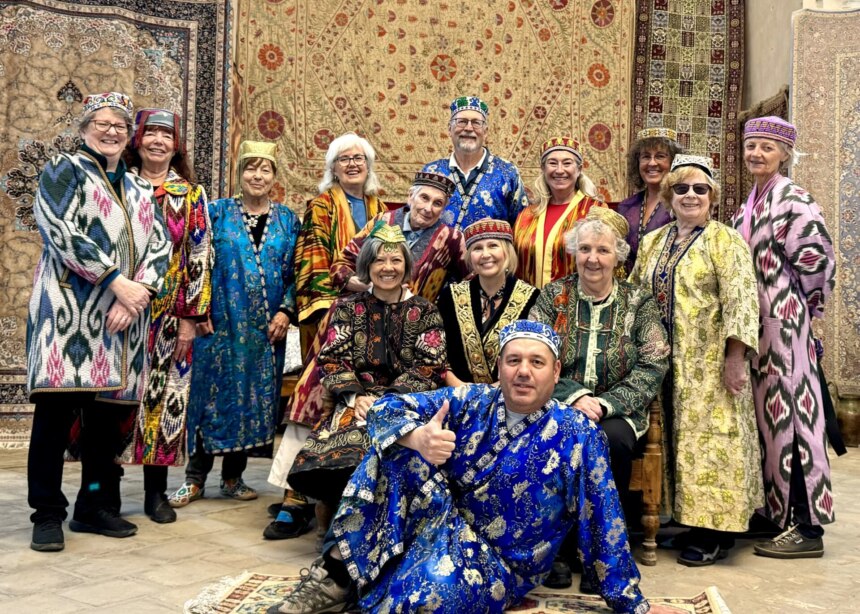
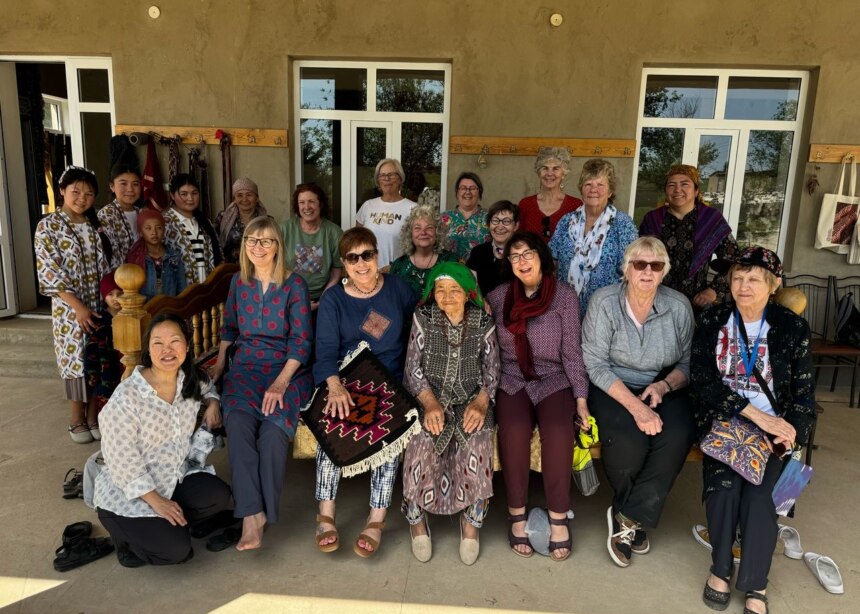
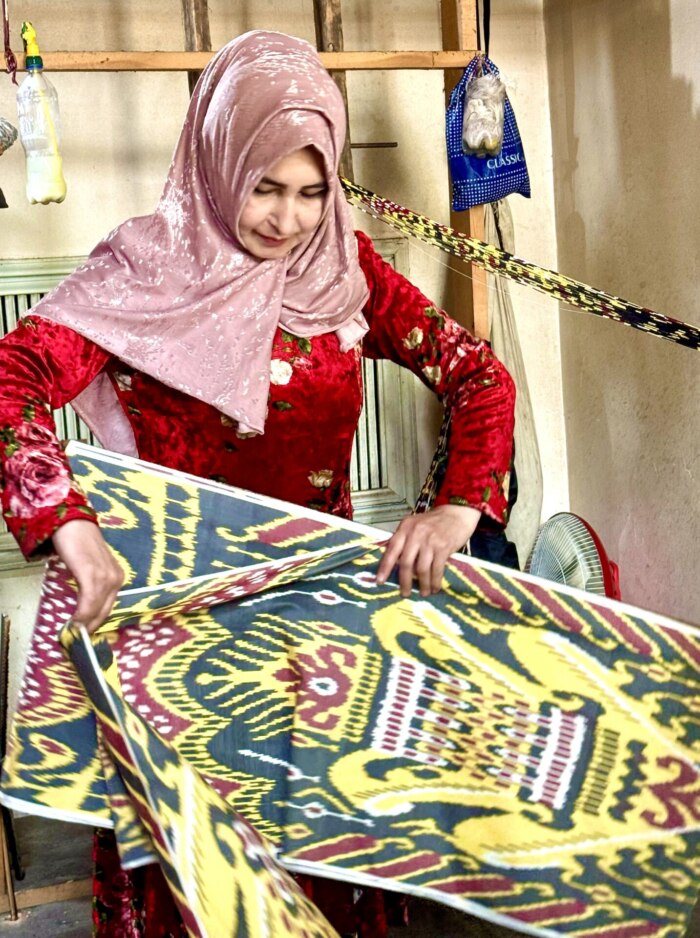

Fergana Valley of Ikat
Next we’ll fly back to Tashkent for one night and then drive to the Fergana Valley. After several hours, we’ll stop in Kokand for lunch and to visit the incredible Khudayarkhan Palace. Along the route we’ll stop several times to visit the bakers slapping dough rounds onto the walls of fiery domed ovens.
Soon we arrive in Margilan, an ancient Fergana Valley city, and home of glowing resist-warp dyed (ikat) fabrics, the most renowned of Uzbek textiles. Margilan town was well-known in antiquity for the superb quality of silk created here. We’ll meet ikat dyers and weavers who are the most skilled in Central Asia. Over the course of our days here, we’ll visit ikat masters to see thread binders, weavers, and dyers. Stunning ceramic plates and bowls will be available at the master ceramicist’s studio we’ll visit too. All the pieces are intricately hand-painted and wood-fired on site.
A highlight will be the Kumtepa Bazaar, one of the best places to buy inexpensive ikat fabrics (woven with resist-dyed warp) which are the most renowned textiles of Uzbekistan. It’s a great local market with an area devoted to vintage and new textiles. Here you can buy ikat yardage to make robes, quilts or pillows, and other textile treasures.
Later we’ll visit an ikat dyeing workshop and will see how the warp threads are bound to make the bold patterns. We’ll visit the Yodgorlik silk factory in Margilan where we can see the entire process from reeling silk cocoons to the finished ikat.
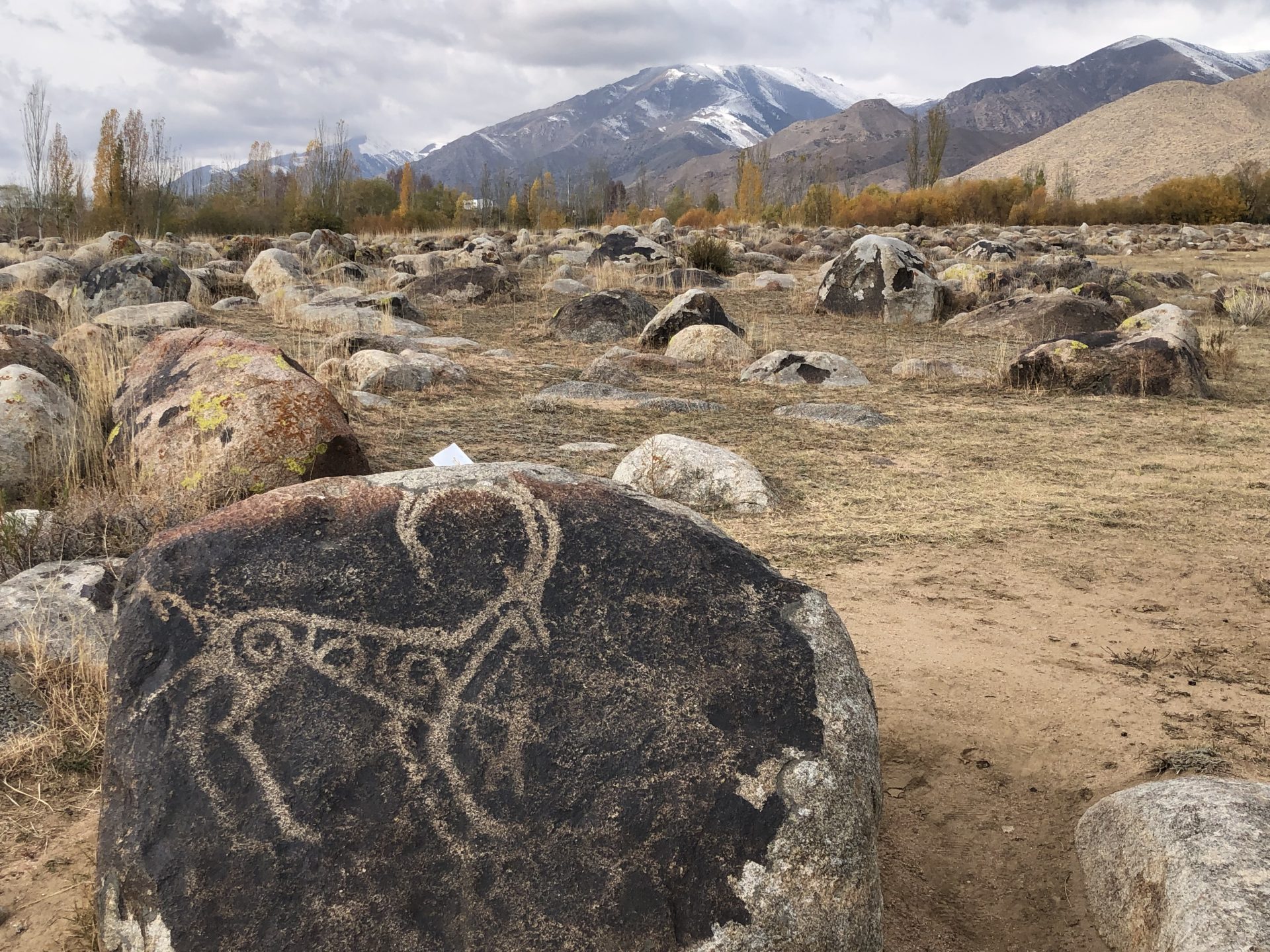
Fascinating Kyrgyzstan
Kyrgyzstan has been at the crossroads of several great civilizations as part of the Silk Road. Though long inhabited by a succession of independent ethnic groups, Kyrgyzstan has periodically fallen under foreign domination. It attained sovereignty as a nation-state after the breakup of the Soviet Union in 1991. Ethnic Kyrgyz make up the majority of the country’s six million people, followed by significant minorities of Uzbeks and Russians.
After the modern cities and the fascinating historical sites of Uzbekistan, a visit to Kyrgyzstan is a refreshing change of pace. The few travelers that make it here love the peaceful countryside and stunning mountain views. In fact, the mountainous Tian Shan region covers 80 per cent of Kyrgyzstan. Some Kyrgyz people still prefer to move with their herds, living part-time in a felt yurt in the beautiful high valleys.
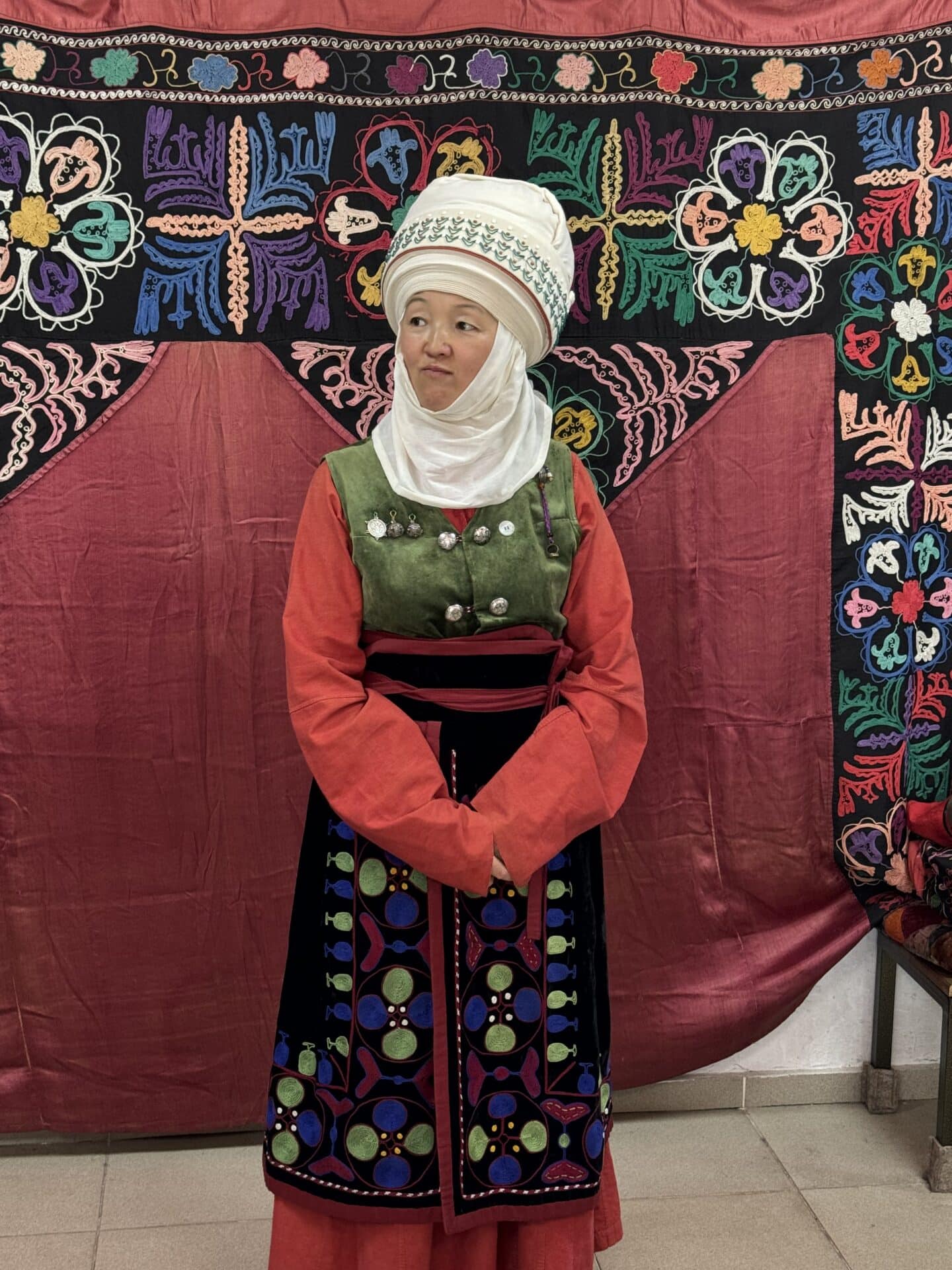
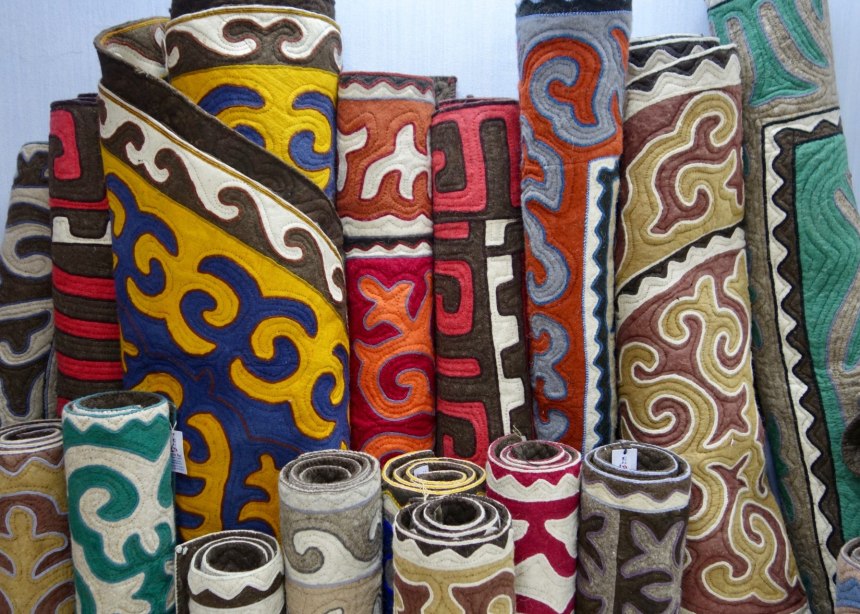
Over the Border Into Kyrgyzstan!
After our time in Uzbekistan, we’ll head over the border with our wonderful Kyrgyz guide who will explain her traditions and culture. We’ll see the highlights of the country, starting in the capital, Bishkek. It’s modern with good restaurants and hotels, pretty parks, and a population of one million. We’ll visit verdant and peaceful Oak Park and other historical monuments in the city. In the fabulous Kyrgyz State (Historical) Museum we’ll learn more about traditional Kyrgyz nomadic culture. There’s a full-sized traditional felt yurt and mannequins dressed in local dress, as well as an excellent collection of felted shyrdak carpets.
We’ll have several opportunities to learn about Kyrgyz felt-making, in NGO supported workshops around the country. Best known for making felted rugs, saddle blankets, and tent bands, Kyrgyz artists also create charming felt toys and clothing such as warm slippers and scarves.
In Bishkek, we’ll meet a talented felt artist, learn about her techniques and see her latest work. Then we’ll try our hand at making a gorgeous silk and wool felted scarf!
We’ll also visit a women’s coop where the felting methods are different. The specialty here is small and adorable needle-felted animals, such as sheep, deer, snow leopards, dogs, panda bears, and yak. We’ll have a workshop to make our own needle-felted animal, usually a sheep, as the easiest one to master. But you could make any creature you envision!
The Beauty of Felt!
Later we’ll drive to Kochkor village, 260 kms from Bishkek. Kochkor is a famous province for farmers and woolen felt makers, and we’ll visit the Altyn Kol Women’s Handicraft Co-operative. We’ll learn how nomadic Kyrgyz women make felt rugs called Shyrdak. These floor coverings are made by cutting positive and negative shapes out of prepared felt in various brightly dyed colors. Then the positive shapes are inserted into the negative spaces of the background and stitched; see photo at right.
Our workshop where you can cut and stitch a small shyrdak mat will give you an appreciation of how much labor goes into each thick felt rug!
The women at the coop will show us another process of felt carpet making. This method of layering strands of colored roving on a felted background is called ala kyiz and is different from the modern art felt shyrdak rugs with cut designs that we have seen before. The backing felt and the front design are sprinkled with hot water, then rolled into a cylinder. One or more people roll the cylinder back and forth with their feet, adding hot water and soap occasionally, for about 45 minutes. The roll is opened and the rug is revealed!
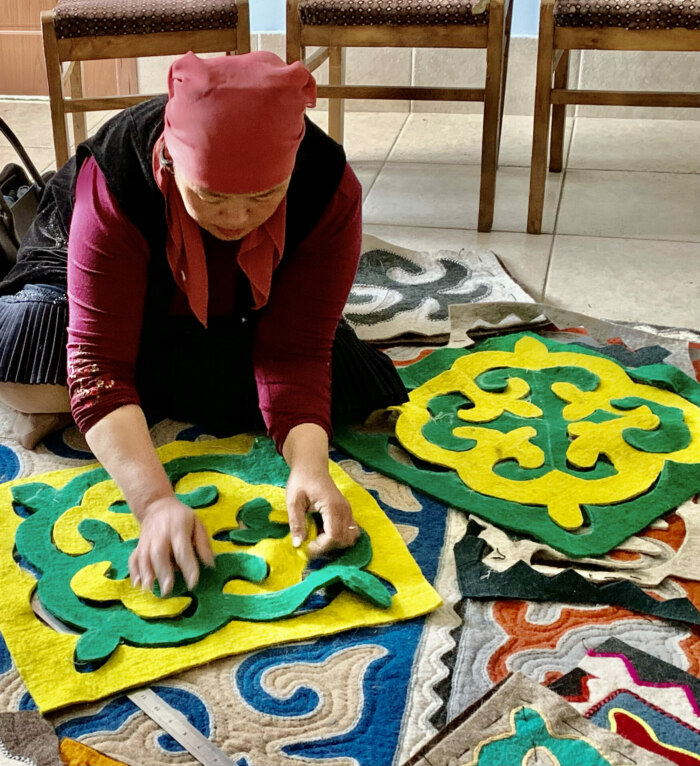
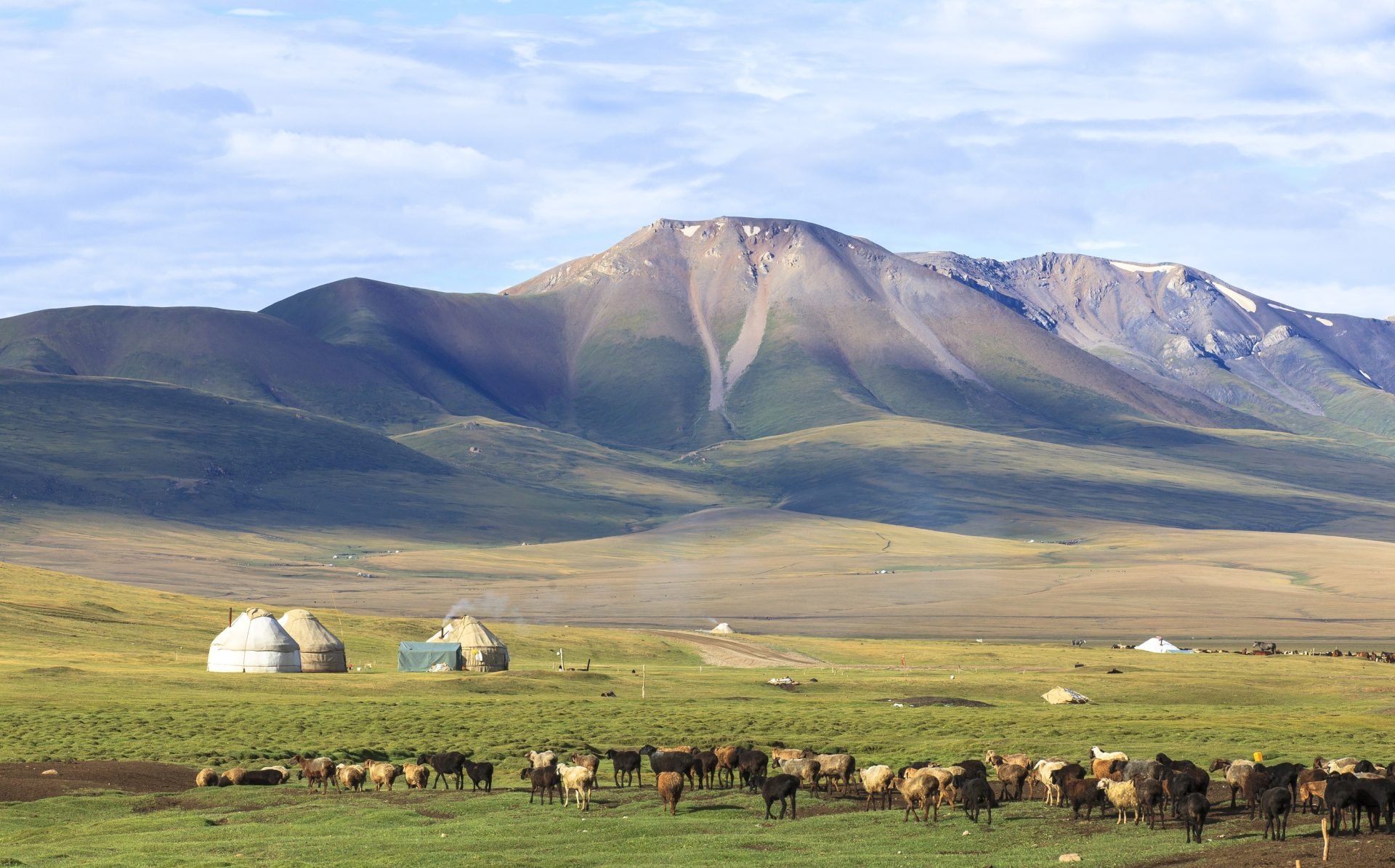
Tien-Shan Mountains
One day we’ll drive along another branch of Silk Road to the Tosh-Rabat stone complex, which may have been a ‘caravanserai’ or inn for traders. More research needs to be done to understand this interesting high altitude site. We take a day trip from Naryn to Tosh Rabat, through the mountains and valleys of the Tien-Shan mountains. Along the route, we’ll see stunning views of the snow-capped At-Bashy ranges.
This well-preserved and mysterious 15th century stone fortress stands 100 km before the Kyrgyz-Chinese border at Torugart, at 10,500 feet altitude. It has a central hall and 30-odd small rooms.
The Tash-Rabat region is spectacular. Mountains are dotted with shaggy near-wild horses, sheep and yak – and maybe leaping Golden Marmots if they are not hibernating. We’ll spend a peaceful night in shared cozy felt yurts at the Yurt Camp near the enormous IssyKul Lake.
On to Karakol
Next morning, we’ll continue to Kyzyl-Tuu village where a Kyrgyz family member will show us how to assemble a felt-sided traditional yurt. Here we will also learn about Kyrgyz national traditions such as beshik (baby cradle ceremony) with a demonstration using a cheerful local babe!
A traditional eagle hunter will demonstrate his Golden Eagle’s skill by letting the eagle loose to chase and snag a goatskin with a chunk of meat attached (no animals harmed in the demo).
We’ll continue to Karakol town, one of the first Russian military outposts, founded in 1869. Here we can see the wooden Russian Orthodox church called the Holy Trinity Cathedral. This masterpiece of woodworking has distinctive wooden cut-work trim all along the eaves. The cathedral was used for many non-religious purposes after the Revolution, but in 1991, following the dissolution of the Soviet Union and the Independence of Kyrgyzstan, the local authority gave the building back to the church; services are held there today for a small congregation. There is also a most unusual pagoda-influenced Chinese mosque with complex woodwork decorations under the eaves.
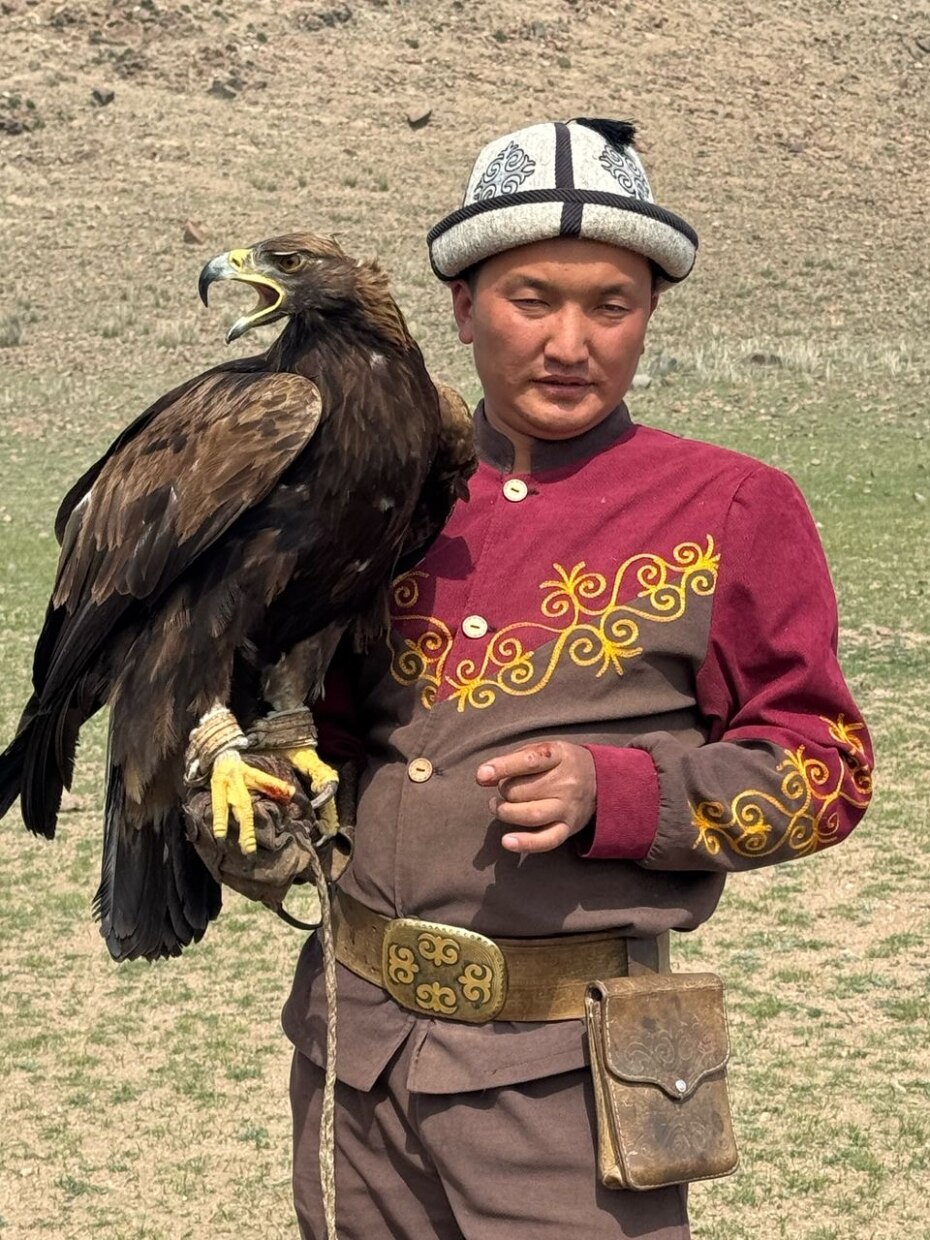
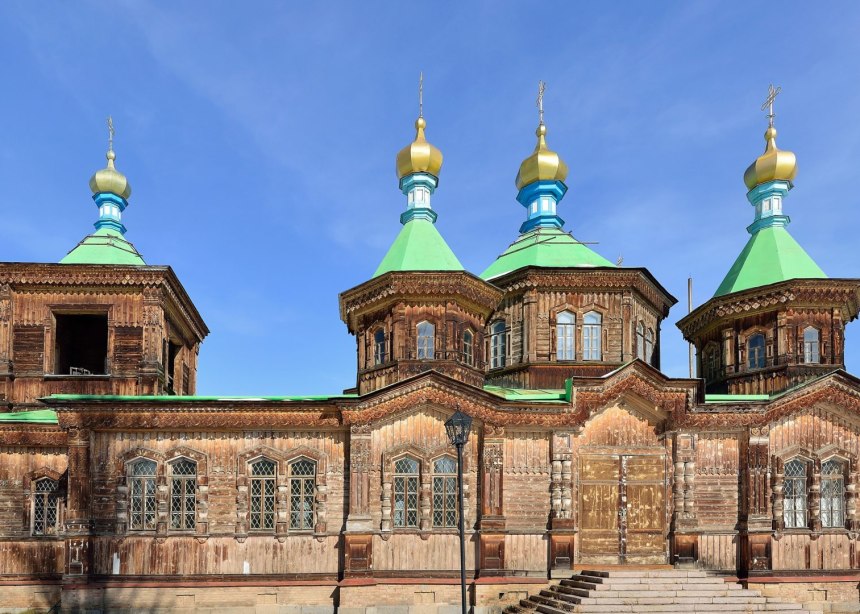
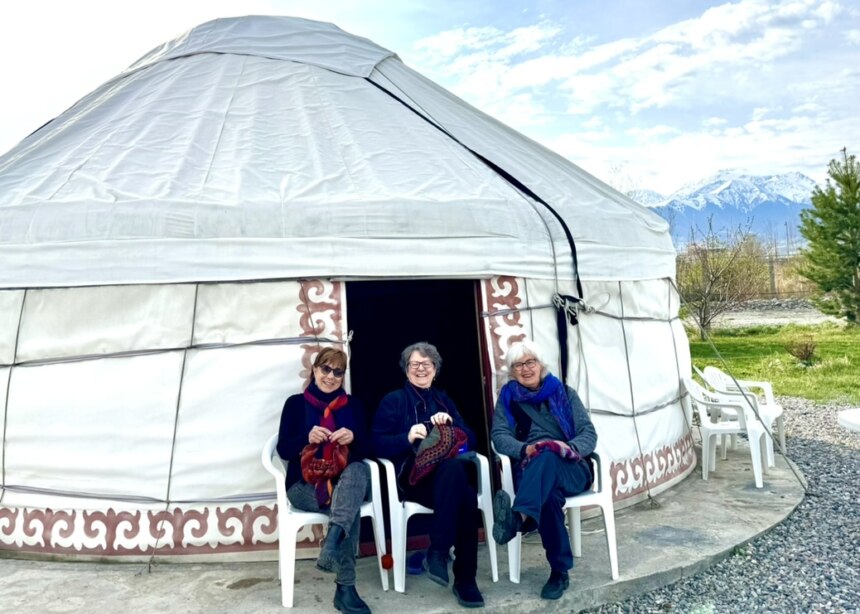
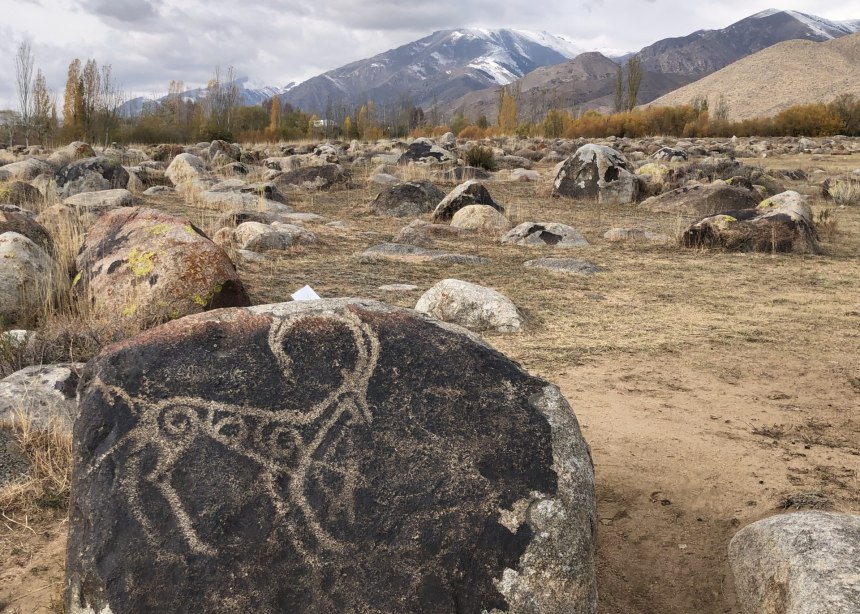
Winding it up with Music…
We’ll have a traditional folk concert with a family of local musicians at the yurt camp. The talented and welcoming family will explain their unique, handmade instruments and play some lively tunes.
Then on our way back to Bishkek we’ll stop to see the enormous field of boulders with ancient rock engravings at Cholpon-Ata’s open-air “museum” or boulder collection with petroglyphs. This is a very important historical site, located on a territory of 42 ha (104 acres). With a splendid background of high snowy mountains, the petroglyphs date back more than 4,000 years.
Finally we’ll return to Bishkek for our Farewell Dinner and a restful night before fly home from FRU, the Bishkek Airport, on April 24. Good-bye to Kyrgyzstan and new friends and old!
Some of our hotels…

Hotel in Tashkent
A modern hotel, conveniently located. The breakfast buffet is excellent. Spacious rooms are comfortable with smooth linens, good beds, and contemporary bathrooms.

Khiva Hotel
Cozy, new family-style hotel within walking distance to all the important sites in Khiva. It has comfortable rooms and good beds. The owner and staff are helpful and very welcoming.
Additional Details & Experiences
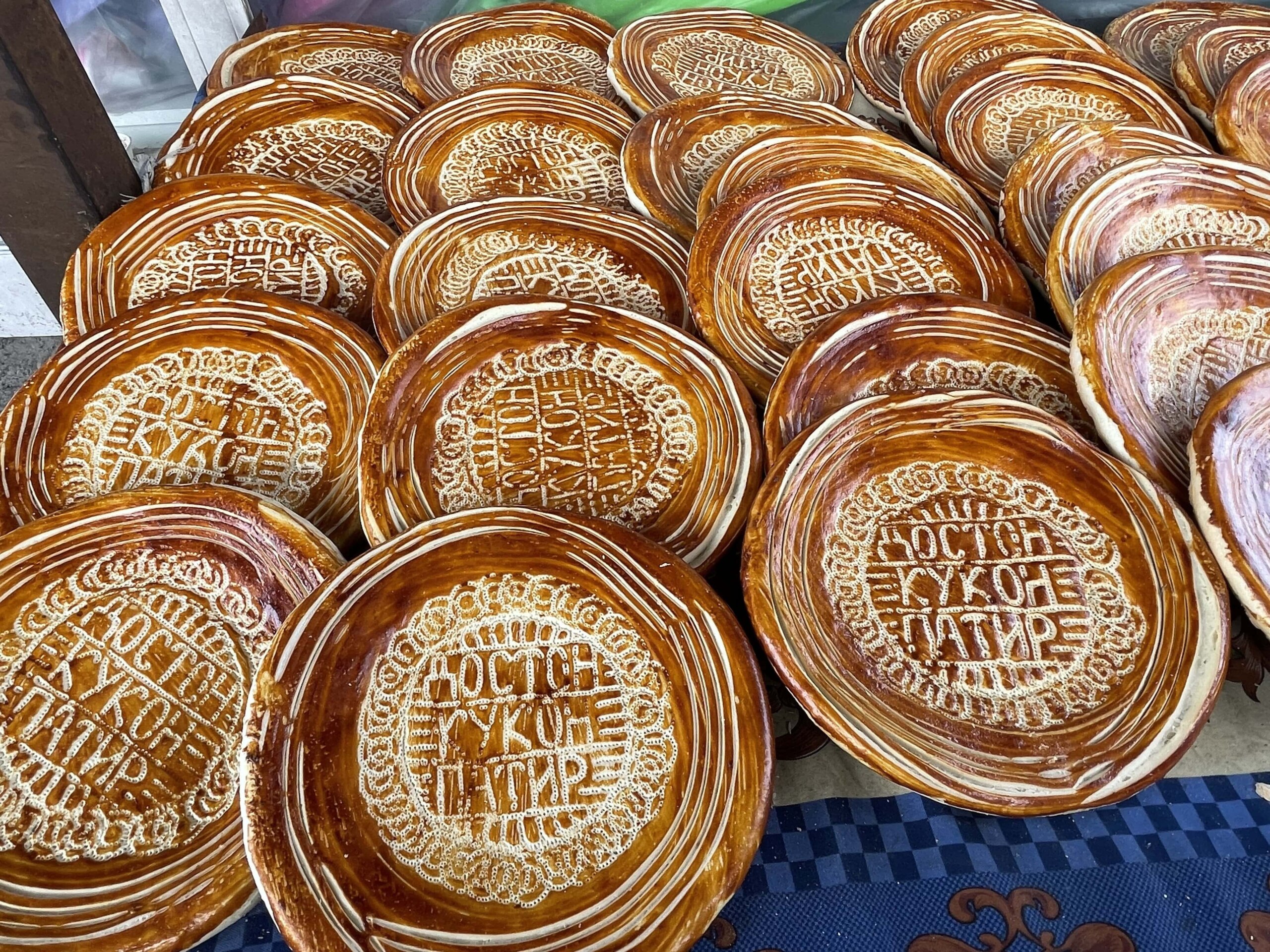
Bread In Uzbekistan
Bread is considered sacred by Uzbek people. Each region has its own type of bread, some chewy, some lighter. The traditional round and flat bread, called non or lepeshka, is baked in a tandoor (round clay oven), after which it comes out toasted and crispy.
Bread of each region has its own particular method of leavening, its own baking techniques and its own inimitable taste. For instance, delicious flaky bread—katlama non—typifies the Fergana Valley version.
All Uzbek bread is marked with a wooden stamp that has small spikes arranged in a design that marks the dough with the baker’s decorative mark and sometimes a telephone number!
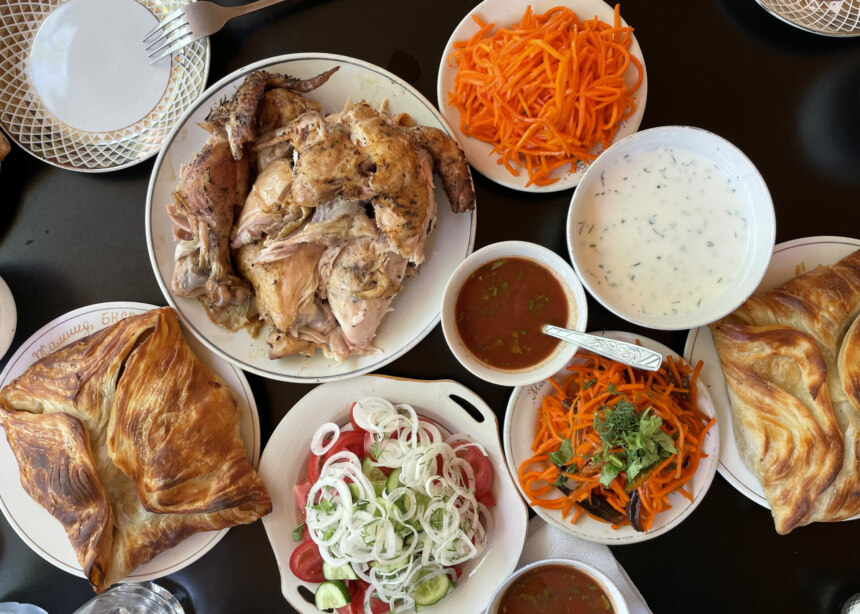
What are the traditional foods of Uzbekistan?
We’ll eat delicious food everywhere! Popular foods include chicken or beef skewers, grilled vegetables, fresh salads and dishes such as rice pilaf or plov, with beef or lamb. Flaky-crusted meat-filled pastries called somsas are common. They’re cooked in a round oven, stuck onto the sides to ensure crisp pastry. Another popular dish is steamed noodle dumplings called manti. These delicious little packages are filled with pumpkin or ground beef. Vegetarians will have no trouble at all; many salads such as grated carrot, tomato and cucumber with feta cubes, or beets with walnuts are popular and found in most restaurants. Soups such as lentil or beet borscht often start the meal. Kyrgyz food is similarly delicious.
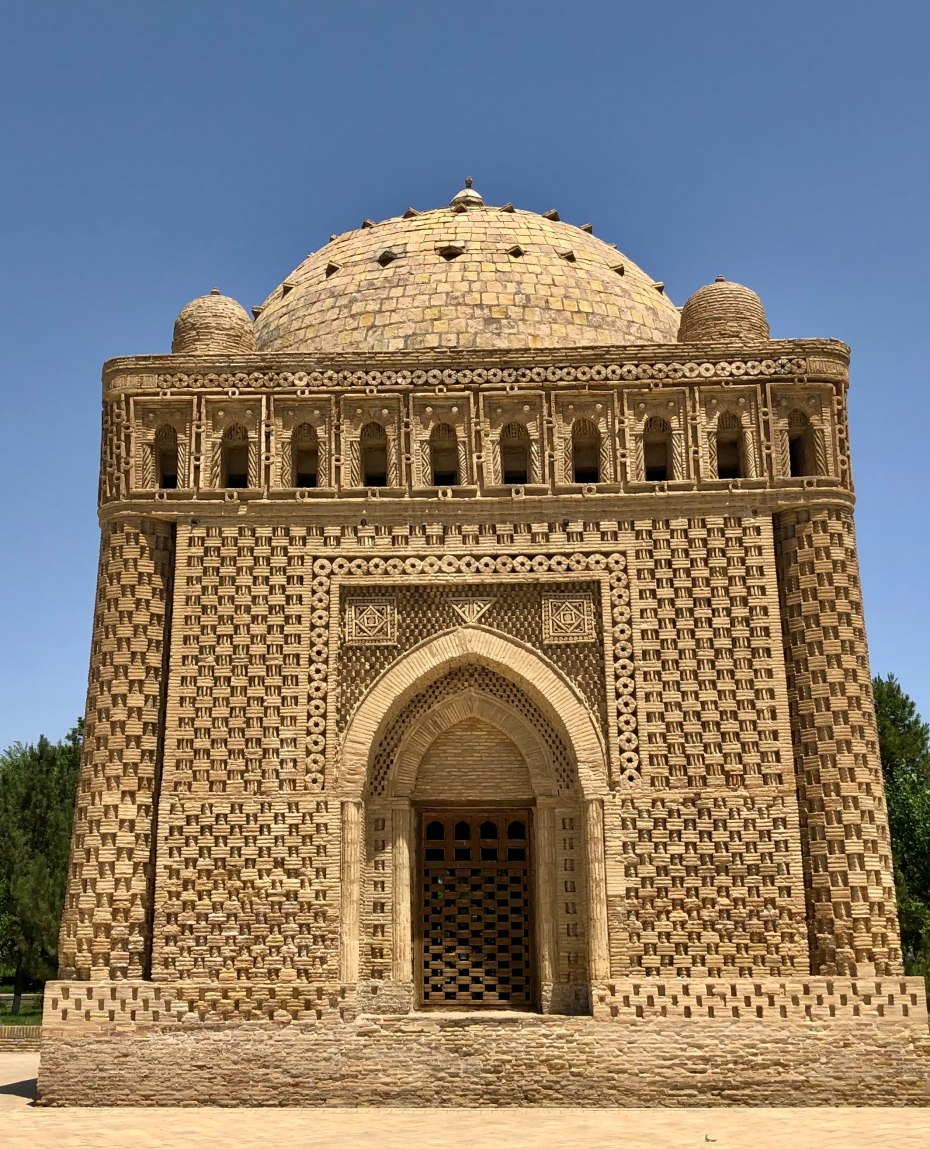
The Ismail Samani Mausoleum
The Samanid Mausoleum is an architectural wonder, a highly decorated perfect cube of unglazed tan bricks. Its thick walls are embellished with decorative basket-weave patterns inside and out. It’s located in the northwestern part of Bukhara, just outside its historic center.
The mausoleum was built in the 9th-10th centuries AD as the resting place of the powerful and influential Islamic Samanid dynasty. It is extremely important from an art historical perspective as it is the earliest example of an Islamic tomb to survive in Central Asia.
Your Trip Leaders
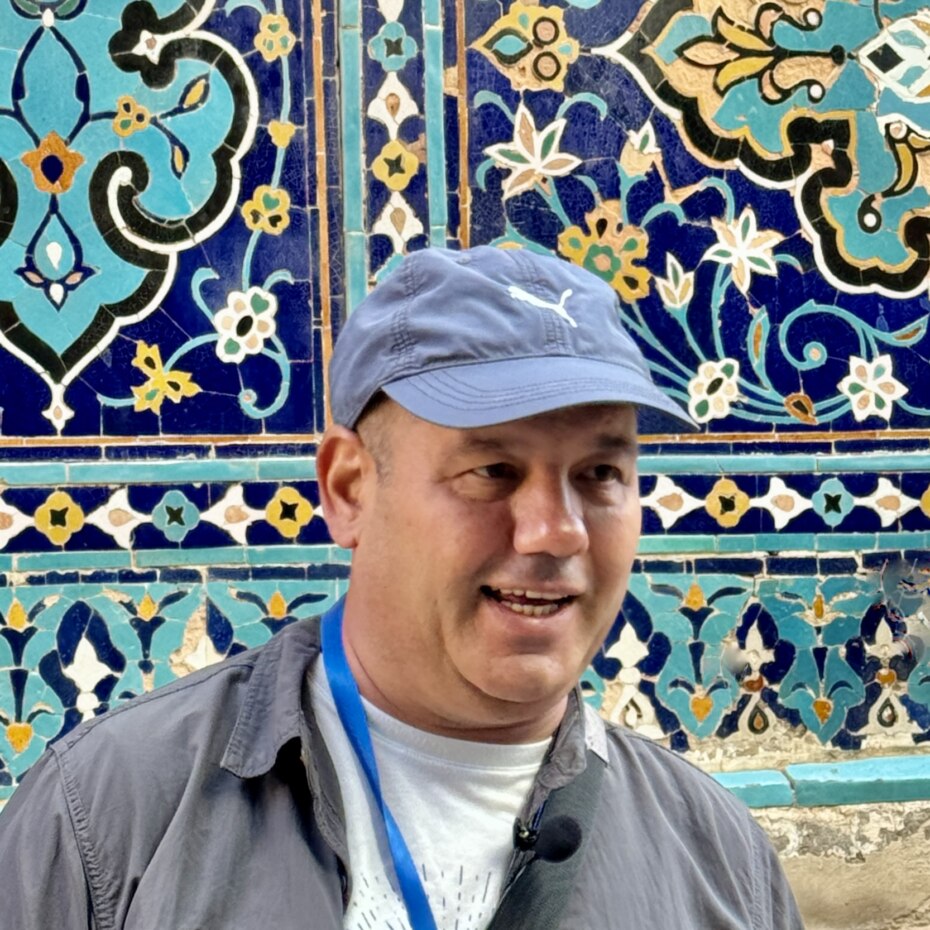
Mirza
Mirza’s upbeat and easy-going personality is a large part of why trips with him are so delightful! He’s a guide who explains just the right amount of the complicated history of his country and its architecture. It would be easy to get overwhelmed by all the conquerors and wars, but Mirza knows just how much info to impart. He’s also friends with the textile and ceramic artisans that we visit, which makes those encounters personal and much more interesting.
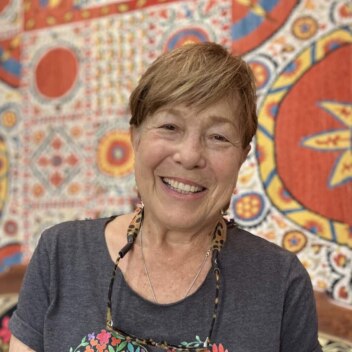
Cynthia
Since 1998 Cynthia has led small groups of textile fanatics and friends all over the world. Favorite destinations include Uzbekistan and Kyrgyzstan for the fabulous textiles, welcoming people, beautiful landscapes and fresh food. In both countries, artisans create exquisite textiles. In Uzbekistan they dye and weave stunning silk ikat designs and in next-door Kyrgyzstan they make striking felted rugs and wall hangings.

Cynthia
Since 1998 Cynthia has led small groups of textile fanatics and friends all over the world. Favorite destinations include Uzbekistan and Kyrgyzstan for the fabulous textiles, welcoming people, beautiful landscapes and fresh food. In both countries, artisans create exquisite textiles. In Uzbekistan they dye and weave stunning silk ikat designs and in next-door Kyrgyzstan they make striking felted rugs and wall hangings.
Check Trip Availability
Trip signups are accepted on a first-come, first serve basis. Please provide your details below and we’ll be in touch to confirm whether spaces are still available for this trip. If you need to get in contact, please email: info@btsadventures.com
Registration Information
- Dates: April 1 – 23, 2026
- Fly Home Date: April 24, 2026
- Deposit: $500
- Tour Cost: 24 Nights – $6,950
- Single Supplement: $650
For more information:
E-mail: info@btsadventures.com
Read: Frequently Asked Questions
Travel Plans
Fly into Istanbul on Turkish Airlines (or any other airlines) and connect with Turkish to a Tashkent flight, arriving on April 1 on one of several flights, depending on the current schedule. The hotel is reserved for the night of March 31 (Night #1) so you can sleep whenever you arrive from the airport, before check-in time.
You’ll fly home from Bishkek on April 24 anytime, typically early in the morning to connect with homebound flights.
Most people fly into Istanbul from their home airport, then connect with Turkish Airlines for the flight to Tashkent, Uzbekistan. For Americans or Canadians living in cities served by Turkish, it is definitely easier to take Turkish Airlines on one “multi-city” ticket for the whole flight itinerary, into Tashkent and home from Bishkek.
There are non-stop flights on Turkish to Istanbul from some American cities such as San Francisco, Los Angeles and Seattle.
Visas
A visa for Uzbekistan is not necessary for travelers over 55 years old! If you are under 55 you will need to apply for an electronic e-Visa through the government’s website – fairly straightforward!. We’ll send visa info closer to departure if you request it.
Right now, Kyrgyzstan doesn’t require any visa for foreign travelers from the USA, Canada, Australia, UK, Turkey, and most of Europe. The list includes many more visa-free countries. citizens of other countries without e-visa privileges can apply for an e-visa online. We will let you know if this policy changes.
What’s Included
- 24 nights of accommodation in double rooms with private bathrooms; one night in a cozy 4-person shared yurt (with “western-style bathroom nearby) in Kyrgyzstan, weather permitting. Single rooms available with supplement.
- Expert Uzbek English-speaking professional guide in Uzbekistan.
- Expert Kyrgyz English-speaking professional guide in Kyrgyzstan.
- Textile expert Cynthia Samake to accompany tour.
- All breakfasts in the hotels
- 24 Lunches and 22 Dinners (2 meals will be on your own on free days)
- Transportation by air-conditioned Minibus
- Entrance fees to all sites and monuments
- Two Flights – Urgench (Khiva) -Tashkent and Osh to Bishkek
- All Tashkent and Bishkek airport transfers
- Modern, fast train travel between Tashkent and Samarkand, Samarkand and Bukhara.
- Mini-bus/Sprinter to Khiva
- All train station transfers – Samarkand, Bukhara, etc.
- Bottled water on all van rides and in hotel rooms.
- Silk and felt scarf workshop of wet felting with modern felt artisans.
- Needle felting workshop to make a small animal with coop women.
- Observe techniques of ikat dyeing and weaving production: from warp creation to binding designs and dyeing fibers.
- Workshop cutting and stitching a mini felt shyrdak with typical motifs
- Demonstrations of shyrdak (cut felt) and ala kyiz (felted roving) rug making.
What’s Not Included
- International flights
- Any visa and passport fees
- 2 meals on your own
- Tips for guides and drivers; amounts will be suggested
- Recommended travel insurance (suggestions about this later)
Frequently Asked Questions
General Questions
What information will I receive after registering?
Once you sign up for a trip, we will e-mail a general itinerary, lists of Suggested Reading, what to take, cultural considerations, weather charts, etc.
How can I get a detailed itinerary for a tour?
A day-to-day itinerary will be sent once you sign up for a trip. If you need specific information about the flow of the trip and the pace of the specific activities, before committing to the trip, get in touch with your questions and we will be happy to fill you in.
What sort of clothing should I bring?
When you sign up for a tour, you’ll receive detailed lists of what to bring to your destination, as well as weather info, to more easily coordinate your wardrobe with the heat or cold.
Your travel clothing will depend on the weather during your stay, in either Spring or Fall. We’ll send a list of weather/temperatures to help you decide on comfort levels, but modest clothing is important at all times. In Kyrgyzstan, we’ll be visiting rural, casual destinations and you will need sturdy shoes for walking around the archeological sites. Bring a walking stick if it might help you walk over rough mountain terrain; we will not be trekking but strolling… over the field of boulders with the petroglyphs, for instance.
What sort of clothing should I bring?
When you sign up for a tour, you’ll receive detailed lists of what to bring to your destination, as well as weather info, to more easily coordinate your wardrobe with the heat or cold.
Do I need any vaccinations or immunizations?
This varies with each country. Make an appointment with your travel doctor/clinic and take your tour itinerary with you. Some areas of certain countries require malaria pills and others do not; same with Yellow Fever and others, such as Cholera and Typhoid. The travel nurse or physician will have all the latest requirements at hand.
OR You can consult the CDC.gov (Center for Disease Control) website information pages for your specific destination so that you have the latest official information.
For all travel, you should be current on your typical childhood and international travel shots such as Polio and Tetanus. Some countries require proof of Yellow Fever vaccination for entry, if you are coming from a country that has yellow fever.
Behind the Scenes Adventures requires you to have had at least two COVID vaccinations. We won’t ask for proof; this requirement is on the Honor System. We recommend you have all available boosters as well.
How much physical activity is involved during the trip?
Each trip has different activity levels that will be fully explained in the specific tour material. But no activities or events are mandatory, and you are always welcome to sit at the bottom of the stairs to a temple or wait in the van while others ascend or visit a particular place. Walking sticks are fine to bring if they help you. We cannot accept wheelchairs or walkers.
For most tours, you’ll need to be able to walk the distance of 4-5 city blocks on your own, with sturdy shoes. Please note that sidewalks in many countries are full of big holes and broken cement chunks, with bits of re-bar sticking out, and you must constantly be alert to these dangers. In urban areas where distances are greater, the group will take taxis and/or get help from local assistants. If you need a personal taxi or additional special aid, that will be at your expense.
What will the weather be like?
Our Uzbekistan trips are planned for temperate weather with little or no rain, in April-May and September-October. Summer temperatures are far too hot! Average daytime temperatures are usually in the 70s and nights can be cooler, in the 50s. With global warming, it is much harder to predict but we will send Weather Charts with your pre-departure info.
What kind of money will we be using?
Purchases are made either in local money, Uzbek SOM for example, or in US dollars. US dollars are stable and the most widely accepted foreign currency, and they are what you should bring. Euros are also accepted. Canadian dollars are not often accepted so you are safer with US dollars. Other currencies are either not accepted, or the rates are not correctly calculated.
Bring US dollars in clean, new-ish, unmarked, unripped bills. $100 bills are fine, but you could bring about a dozen $20s also just in case you want to buy smaller items, in places that accept dollars. I will hand out currency exchange charts when we meet.Purchases are made either in local money, Uzbek SOM for example, or in US dollars. US dollars are stable and the most widely accepted foreign currency, and they are what you should bring. Euros are also accepted. Canadian dollars are not often accepted so you are safer with US dollars. Other currencies are either not accepted, or the rates are not correctly calculated. Bring US dollars in clean, new-ish, unmarked, unripped bills. $100 bills are fine, but you could bring about a dozen $20s also just in case you want to buy smaller items, in places that accept dollars. I will hand out currency exchange charts when we meet.
Do NOT count on using ATMs, although their service is much better nowadays. They exist but can be out of money, or the systems are down, etc.
Credit cards might be accepted for large purchases with a surcharge at more modern shops, but definitely will not be accepted for small items in markets, and small shops.
It’s easy! BRING plenty of CASH dollars, and just take home what you don’t spend. You will keep your US bills in your secret waist pouch or your wallet. You can lock extra money inside your suitcase in the hotel also; we know and trust the hotels where we stay.
How do I change money to buy textiles and other items if I need local money?
We will go as a group to a currency exchange place when we arrive in each country, to change our clean, new-ish, unmarked, unripped US dollar bills into SOM or other local currency. Some places that we shop will accept dollars or credit cards but since there is a high fee for them, merchants greatly prefer cash – dollars or local money.
How much money should I bring for the trip?
Since your trip fee includes all the necessities, you will need spending money only for alcoholic drinks, guide and driver tips, and textiles and souvenirs that you decide to buy.
There are many exciting and beautiful textiles, yardage, and fashionable clothes to take home with you! Bring as much cash as you can afford to spend, or that you’ve budgeted for, and plan on using a credit card for any large unplanned purchases like rugs or vintage suzanis. You can always return to the US with any extra, un-spent dollars.
What kind of electrical adapter will I need?
You will need little adapters for our typical flat-pronged plugs that make them fit the round sockets below. Find these at any travel store, online individually (from you-know-who), or as a set, or at Target, etc. You will need them since most hotels and riads have only sockets that accept round prongs.
NOTE that these are not converters; they do not step down the 220v. electricity. Be sure all your chargers and hair dryers, etc. say INPUT: 110 to 220 or 240 v.
Most chargers now say INPUT: 110 to 220 or 240 volts; many hair dryers do not, and you will fry the device if plugged in without a converter. They are larger and more expensive than adapters; get dual-current devices instead of needing a converter. I never travel with a converter, but things like C-pap machines might require one. Better yet, find a hair style that doesn’t need a dryer, LOL.
Type E

- Primarily used in France, Belgium, Poland, Slovakia & the Czech Republic AND MOROCCO, etc.
- 2 ROUND pins, grounded
- 16 A
- 220 – 240 V socket compatible with plug types C, E & F
Type C

- MORE COMMON than above version, not grounded
- Commonly used in Europe, South America & Asia
- 2 round pins, skinnier than Type E
- 2.5 A — almost always 220 – 240 V
- Socket compatible with plug type C
Meals & Accommodations
What sort of food will we be eating?
Uzbek food is fresh and delicious. There is an excellent variety of salads without lettuce, including grated carrots, beets, and other fresh choices. Chicken or beef kebabs are popular and delicious. There are some good hot and cold soups, such as a cold yogurt and cucumber version, so refreshing in warmer months. Lagman is a delicious thick noodle soup with bits of beef.
Other popular dishes are samosas, meat or vegetable-filled pies baked in a round tandoor oven, and the Uzbek national dish called Plov. Typical blue-collar lunch plov mixtures served from huge cauldrons are greasy but other healthier and delicious plov versions include lots of yellow and orange carrots, garbanzos, and raisins. Uzbekistan is famous for fresh-baked bread and bakeries. Every meal starts with fresh bread, sometimes with grilled onions incorporated (my favorite!).
Will I be able to accommodate my dietary needs?
If you have any special dietary, health, or nutrition issues, restrictions, etc, there is no guarantee that
Behind the Scenes Adventures will be able to accommodate your special diets in foreign countries.
Please contact us before departure, and bring sufficient alternative foods. Travelers with severe peanut allergies or other life-threatening allergies cannot be accepted. Vegan diets are possible but with much less variety than at home. Vegetarian or gluten-free diets are often fairly easy to accommodate, but also with less variety than what is available at home. Note that the guide and tour leader cannot cater to your special diet in a group; you’ll be responsible for choosing foods you can eat.
Flights & Travel
Will I need a visa for connecting countries?
It is very rare to need a visa for a connection if you stay in the Transit area. This will be regulated by the connecting country and the airline will send information as to this requirement.
Will I be met at the airport?
Yes! A driver (and the guide if possible) will meet you with a sign – beariing your name and/or Behind the Scenes Adventures. The driver will have your flight schedule and he will know that you need time to pick up your luggage. Wait for him in the terminal, right outside the Arrivals area, and don’t go with any other drivers that don’t have your name on a placard.
For each trip, we’ll send more specific info about the exact pick-up spot. The driver will help with your luggage and a small tip of $5 USD would be appreciated anywhere..
What are the requirements for my passport to be valid?
Your passport needs to have one blank page for your visa, although, with an E-Visa, you will have just a piece of paper to show, and don’t need room for anything except Immigration stamps in your passport.
What is the best airline to fly to the country?
Turkish Airlines is the easiest, depending on where you live….You will need to get to Istanbul, Turkey, then connect to Tashkent. There are non-stop flights to Istanbul’s fabulous new airport (code IST) from SFO and LAX, and perhaps other major cities. Try to get a non-stop flight; it’s much easier not to have to change planes. Some flights connect in Istanbul for an hour or two, then continue directly to Tashkent – easy!
I found good deals on Expedia.com with Turkish Airlines which is very good; they are a partner of United. Turkish and United are the airlines I always use but from your home airport, there may be other deals with other airlines such as Delta and Air France, etc.
What will we use for transportation?
We use a Mercedes Sprinter for most interior transportation. It is high-topped and spacious, and our luggage is stored in the back, or on top if we amass extra bags along the way. (This is another reason we must start with a luggage limit.)
With a small group, we may use a Chevrolet SUV (made in Uzbekistan!) for the whole trip. Vans and buses are not allowed on the route from Tashkent to Ferghana Valley, so we will go in Chevy SUVs. And we will take the modern high-speed train, from Tashkent to Samarkand and on to Bukhara.
We will also fly on two interior/domestic flights.
